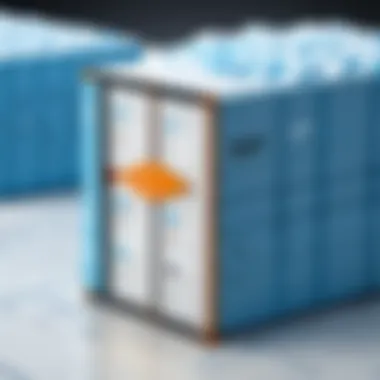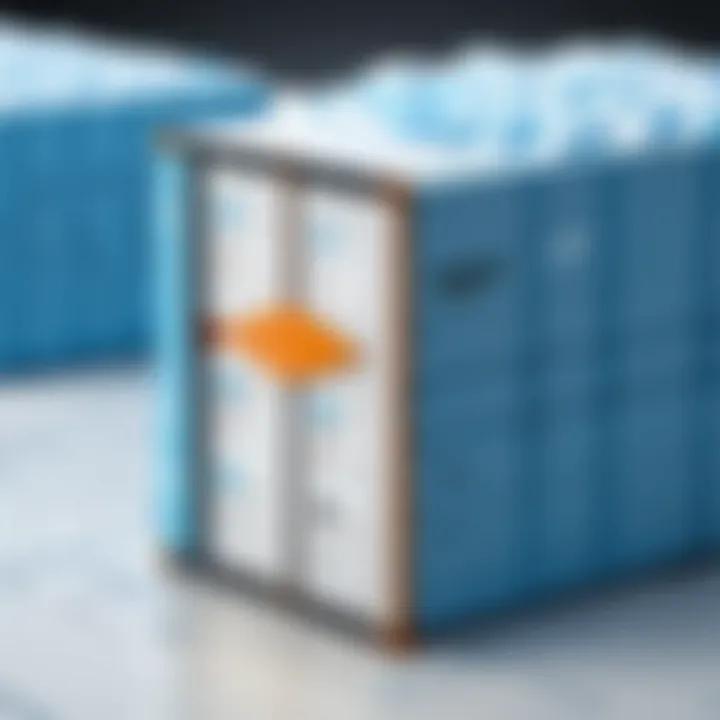Migrating Data from Amazon S3 to Glacier Storage


Intro
In an age where data is often seen as the new oil, managing it efficiently can make or break an organization. Imagine having files that you hardly access but are critical for compliance or archival purposes. This is where the transition from Amazon S3 to Glacier storage becomes significant. The motivations for this shift can vary widely—from saving costs to ensuring regulatory compliance. By strategically migrating data to Glacier, organizations can manage their storage tiers in a way that aligns both with immediate needs and long-term goals.
This article aims to guide you through the nuances of moving data from Amazon S3, a more accessible storage solution, to Glacier, which is specifically designed for data archiving and long-term backup. Along the way, we will delve into the implications of such a transition, uncovering the key steps involved and the best practices to maximize benefits while minimizing risks.
Overview of Software
Purpose and Use Cases
Amazon Web Services (AWS) offers various solutions for cloud storage, and two of the most popular among them are Amazon S3 and Glacier. While S3 is designed for high-frequency access, Glacier caters to the need for long-term data storage with infrequent retrieval. Organizations often look to transition data to Glacier when they're confident that certain datasets won’t be touched for extended periods. This can include:
- Legal and compliance data: Maintaining records for audit trails.
- Historical data: Company financial records or transaction logs that are rarely accessed but must be kept.
- Research data: Archived datasets from completed projects that still hold value for future reference.
Key Features
Glacier's primary draw is its cost-effectiveness and ability to handle bulk data storage. Key features include:
- Low-cost archival storage: Pricing that is competitive, particularly for large volumes of data.
- Data retrieval options: Flexible retrieval times ranging from minutes to hours.
- Integration with S3: Seamless transitioning as both solutions exist within the same AWS ecosystem, allowing for simple management processes.
Steps to Transition Data from S3 to Glacier
Preparation Phase
Before making the migration, preparation is key. This involves:
- Assessing your data: Examine the datasets in S3 to determine which ones are suitable for Glacier.
- Cost analysis: Understanding the cost implications of keeping data in S3 versus in Glacier helps in making informed decisions.
- Backup strategies: Ensure that you have backups of critical data before beginning the migration process.
Execution Phase
Once you feel ready, executing the migration involves a few detailed steps:
- Accessing your AWS Management Console and navigating to the S3 bucket containing your data.
- Selecting the files you wish to migrate. You can choose individual files or entire folders, depending on what needs archiving.
- Initiating the transfer: Utilize the AWS CLI or a suitable SDK to transition selected data to Glacier storage. A sample command using AWS CLI is as follows:
Post-Migration Review
After migrating data to Glacier, it’s essential to review the transition:
- Verify data integrity: Check that the data has been migrated successfully and hasn’t been corrupted or lost in transit.
- Reassess storage strategies: Regularly review and adjust your storage policies as data needs evolve over time.
Ending
Transitioning from Amazon S3 to Glacier is not merely a technical process but an astute strategic initiative. Understanding when and how to make this shift can greatly enhance your data management strategy. In this landscape where every byte counts, ensuring that your long-term storage solutions align with business objectives is vital.
By utilizing the insights outlined in this article, organizations can navigate this transition with greater awareness, optimizing both costs and data accessibility.
"Data is like a resource; manage it wisely, and it will serve you well in the long run."
For further reading, you can check Amazon’s official documentation on AWS Glacier or explore community discussions on Reddit.
Preamble to Amazon S3 and Glacier
In the vast landscape of cloud storage, understanding the nuances between Amazon S3 and Glacier is pivotal for many organizations looking to manage their data effectively. This section aims to unravel the critical components of both services, highlighting their distinct benefits and considerations when it comes to transitioning data.
Understanding Cloud Storage Solutions
Cloud storage solutions have transformed the way data is handled, facilitating easy access and sufficient scalability. They allow businesses to store and retrieve data via the Internet, streamlining operations and promoting flexibility—two aspects that today's tech-savvy enterprises can't afford to overlook. Different categories of cloud storage exist, including block storage, file storage, and object storage. The latter is crucial in our discussion, as Amazon S3 and Glacier fall under this category.
The beauty of cloud storage lies in its ability to store vast amounts of data without the physical limitations of traditional hardware. Moreover, it provides different access tiers to cater to various needs—proactive access for frequently used data and archival tiers for long-term storage without the day-to-day retrieval demands. This balance is essential for businesses facing tight budgets and storage limitations, as it enables them to efficiently manage their data lifecycle while optimizing costs.
Overview of Amazon S3
Amazon Simple Storage Service (S3) stands as a stalwart in cloud storage solutions. It offers high availability, data redundancy, and robust performance to handle a wide array of use cases from backup solutions to hosting website files. The flexible pricing model allows users to pay only for what they use, making it an attractive option for startups and large enterprises alike.
Data in S3 is categorized into buckets—a repository where objects reside. Users can store an impressive amount of data per bucket, making it easy to keep files organized. Furthermore, S3 provides various storage classes, catering to different access needs: S3 Standard for general-purpose, S3 Intelligent-Tiering for automatic cost optimization, and S3 One Zone-IA for infrequently accessed data. Leveraging these features enables organizations to store and retrieve data with ease, ensuring they can meet both current and future demands efficiently.
Intro to Glacier Storage
Transitioning to glacier storage is where the discussions get even more interesting. Amazon Glacier, now often referred to as Amazon S3 Glacier, serves as a dedicated service optimized for long-term data archiving. It offers significantly lower storage costs compared to S3, making it an economical choice for data that is rarely accessed. Organizations can shift massive datasets into Glacier and enjoy substantial cost savings without sacrificing the integrity or safety of their data.


One might think of Glacier as "cold storage," which implies a longer delay in retrieving the data. It’s important to recognize that retrieval from Glacier is designed to be somewhat slower than S3; however, it allows for various retrieval options depending on urgency—a factor worth considering when planning your data transition. Organizations can retain their essential data for compliance or historical purposes while still managing their expenses, a balance that is often harder to achieve with traditional storage solutions.
"The strategic migration to Glacier isn’t merely about cutting costs—it's about optimizing your data strategy in a cloud-centric world."
In summary, understanding Amazon S3 and Glacier serves as a foundational knowledge for anyone looking to navigate the transition of data between the two. As we delve deeper into specific reasons for migration and the technical processes involved, the importance of this foundational knowledge will only grow.
Reasons to Move Data to Glacier
Transitioning from Amazon S3 to Glacier storage is not just a technical shift; it's an alignment with strategic foresight. The reasons to embrace Glacier go beyond mere storage capabilities; they encapsulate financial prudence, long-term planning, and adherence to regulatory demands. Before diving into specifics, let's set the stage for why these reasons are crucial for anyone handling substantial volumes of data.
Cost Efficiency
One of the prominent factors guiding the decision to transfer data to Glacier is cost efficiency. Typically, Amazon S3 serves as a primary storage solution, but maintaining vast amounts of data in S3 can be a financial drain. Glacier is built for long-term storage, making it significantly cheaper for data that is accessed infrequently.
The savings can be staggering. For instance, using Glacier can cut storage costs by over 90% compared to S3 Standard. Companies should calculate their current storage expenses and project them into the future. Will your data still need to sit in S3, costing you more than a pretty penny?
"Switching to Glacier can feel like finding a hidden savings account in your business budget."
Furthermore, businesses can consider automating their data transfer via S3 lifecycle policies, ensuring that as data becomes less active over time, it is seamlessly moved to Glacier, optimizing cost as well as workflow.
Long-term Storage Needs
Companies today face the challenge of data management on an unprecedented scale. With light-speed advancements in technology and an ever-increasing flood of data, businesses need to think long-term to avoid drowning in their own data.
Glacier is tailored for this very purpose. It is ideal for data that requires preservation for extended periods but isn't actively accessed. For example, historical financial records or completed project data fall into this category. With Glacier, such data can be safeguarded without incurring excessive costs, freeing up the more expensive storage in S3 for active data.
Organizations should assess their data needs and consider what can be archived. Scrutinizing data lifecycle will help identify potential candidates for Glacier storage. Whether internally or through consultants, evaluate your data's relevance and decide what can be archived for future reference.
Regulatory Compliance
The importance of regulatory compliance cannot be overstated. Many industries, notably finance and healthcare, are governed by stringent rules regarding data retention and accessibility. Failing to comply can result in hefty fines and reputational damage.
Glacier provides a structured avenue for maintaining compliance as it safeguards data for as long as required. Specific laws may dictate how long certain types of data need to be stored.
For example, GDPR requires that personal data be stored only as long as necessary, while Sarbanes-Oxley dictates financial records be retained for a minimum of seven years. Glacier is a reliable option to comply with these mandates, ensuring that vital records are formatted appropriately and kept secure.
In summary, transitioning to Glacier storage offers numerous advantages, including significant cost savings, a long-term strategy for managing data growth, and compliance with legal requirements. All these factors combined create a compelling case for considering Glacier as an integral part of any organization's data management strategy.
Data Management Lifecycle
Defining the Data Lifecycle
In essence, the data lifecycle encompasses several stages that data goes through during its existence. These stages typically include:
- Creation/Collection: This is where information is generated and initially stored.
- Storage: At this juncture, data is organized and held in either primary or secondary storage locations like S3.
- Use: The information is accessed and utilized by personnel or applications, which may vary in frequency.
- Archiving: Data that is no longer actively used but still required for compliance, historical reference, or potential future use can be relocated to a more cost-effective memory. This is a key stage leading to moving data to Glacier.
- Destruction: When the data is deemed unnecessary and meets the retention policy guidelines, it can be permanently deleted.
A clear understanding of these stages is crucial, as it guides organizations on how to handle their data properly, ensuring that at each stage, data is not only protected but also utilized effectively.
Categorizing Data for Transition
The categorization of data is an often-overlooked aspect of data management, yet it's profoundly important when planning the transition to Glacier storage. Accurate categorization allows organizations to make informed decisions on which data to move and which to keep active.
Here are some considerations to keep in mind:
- Data Sensitivity: Determine if the data contains sensitive information. Regulated data might necessitate specific handling procedures during and after transition.
- Access Frequency: Identify how often data is accessed. Data with low access frequency is typically a good candidate for Glacier, as it can be retrieved when necessary without affecting overall workflow.
- Retention Period: Consider how long the data must be retained. Items with longer retention needs fit well within Glacier’s framework.
- Compliance Needs: Regulatory frameworks may dictate how certain data must be stored or accessed, influencing categorization decisions.
Utilizing a systematic categorization approach primes the organization for efficient migration, preventing potential pitfalls, and contributing to a streamlined data management policy. Through this careful analysis, a business not only makes the most of its resources but also fosters an environment of strategic decision-making.
Technical Process of Moving Data
When it comes to transitioning data from Amazon S3 to Glacier storage, understanding the technical process is paramount. This migration isn't merely about shifting bits and bytes; it involves a well-thought-out strategy that considers various technical elements, efficiency, and potential impacts on your data management practices. Getting this process right can save time, resources, and prevent data loss—essential in today's fast-paced digital world.
Prerequisites for Migration
Before embarking on the journey to move your data, it’s key to ensure that several prerequisites are in place:
- Understand Your Data Volume: Assess how much data you aim to transfer. Large volumes might require special handling to avoid bottlenecking.
- Set Up IAM Roles: Ensure you have the necessary Identity and Access Management (IAM) roles established. Permissions dictate who can perform the migration and might involve creating policies that allow actions like and .
- Backup Your Data: Create a backup of your data just in case something goes awry during migration. This ensures you can recover lost information.
- Brush Up on Storage Classes: Familiarize yourself with Amazon's storage classes. Understanding differences between S3 and Glacier can clarify why and when to migrate.
Step-by-Step Migration Tutorial
The migration process can seem daunting initially. However, breaking it down allows for a smoother transition:
- Identify Data for Migration: Focus on data that's infrequently accessed or hasn’t been used recently. Assess using analytics tools available in AWS.
- Prepare Migration Plan: Draft a plan that includes timelines, target storage classes, and the process for retrieving data if needed.
- Use AWS SDK or CLI: Automated tools can streamline the process by allowing scriptable commands. It’s quite handy to build scripts that can automate bulk transfers.
- Execute Migration: Run the script or commands. Make sure to monitor progress actively. If glitches occur, address them before they escalate.
- Verify Data Integrity: Post-migration, it's crucial to validate that all data transfers successful. You can do this by comparing checksums pre and post-migration.


Utilizing AWS Management Console
The AWS Management Console is a powerful tool in your migration arsenal. Here’s how to leverage its capabilities:
- Intuitive Interface: The console provides an easy-to-navigate interface, making it simpler to manage your S3 buckets and Glacier archives.
- Visualize Data Management: Use the console to visualize your storage structure. It makes it easier to pinpoint what needs to be transferred.
- Monitor Migration Status: It allows you to check the status of your data migration in real-time. This feature is helpful to gauge performance and spot potential issues quickly.
Behind every successful data migration is a well-defined process supported by the right tools. Missing just one of these crucial steps could ruffle feathers down the line, so ensure you take every step methodically. Remember, your data’s journey from S3 to Glacier is a significant aspect of your overall cloud storage strategy, reflecting directly on your organization’s efficiency and cost-effectiveness.
"A pound of prevention is worth an ounce of cure." - This adage rings especially true in cloud storage migration.
Automation and Tools
In the realm of cloud storage, transitioning data between services should not be a painstaking task. This is where automation and tools come into play, significantly simplifying the process of moving data from Amazon S3 to Glacier storage. Automation not only alleviates repetitive manual tasks but also enhances accuracy, reduces the margin for human error, and saves precious time.
The ability to set up seamless transfers means less time worrying about migration logistics and more focus on strategic data management. With automation, IT professionals can orchestrate bulk actions with a few simple scripts, allowing for a more efficient workflow. The combination of the right tools with automation can lead to considerable cost savings over time, especially for businesses managing large volumes of data.
To explore this further, let’s dive into two pivotal components in automation: the AWS SDK and CLI, and S3 lifecycle policies.
AWS SDK and
Using the AWS SDK or Command Line Interface (CLI) can truly streamline the process of transferring data to Glacier. The SDK provides an accessible way for developers to interact with AWS services through various programming languages. Whether you're crafting small applications or managing large-scale data operations, the SDK is invaluable.
When automating data transfers, the CLI is particularly handy for quick and effective commands.
Here is a simple example to illustrate how the CLI can be used to move data:
This command copies a file into an archived folder. You can also script complex workflows, allowing you to schedule transfers during off-peak hours, thus optimizing your resources.
Incorporating automated processes like this can also assist with maintaining compliance and ensuring data integrity throughout the migration journey.
S3 Lifecycle Policies
Implementing S3 Lifecycle Policies is another effective method for automation in this transition. These policies enable you to define rules based on the age or size of files. For instance, your policy could state that files that haven’t been accessed in 30 days should automatically transition to Glacier storage.
The key benefits of lifecycle policies include:
- Automated Management: Once set, rules execute without any manual intervention, allowing for a hands-off management experience.
- Cost-Effectiveness: By automatically moving older files to Glacier, you minimize ongoing storage costs while keeping your most active data in S3.
- Ease of Implementation: Configuring lifecycle policies is straightforward, even for those who may not have extensive technical skills. AWS provides a user-friendly console to manage these rules effectively.
To create a lifecycle policy:
- Navigate to the S3 console.
- Select the bucket you want to set policies for.
- Under the Management tab, add a Lifecycle rule.
- Define the criteria for moving objects to Glacier.
"Automation is not just a trend; it's an essential element that improves operational efficiency in cloud management."
Best Practices for Efficient Migration
As organizations shift large datasets from Amazon S3 to Glacier storage, it becomes critical to implement effective practices. This ensures that the transition is not only smooth but also economically feasible. By adhering to best practices, one can minimize downtime and mitigate risks associated with data loss or retrieval delays.
Assessing Data Redundancy
Before migrating data, it’s essential to take stock of what’s actually on hand. Understanding data redundancy can play a significant role in streamlining migration. One may ask: "Do I have multiple copies of the same file?"
- Perform a thorough audit of your dataset by utilizing tools like AWS S3 Inventory. This tool can help identify objects with multiple copies, enabling you to decide what's necessary to migrate and what's not.
- Classify the data based on usage frequency and necessity. Data that isn’t often accessed might be a prime candidate for Glacier.
Identifying redundant data can lead to significant cost savings. After all, why pay to transfer and store data that’s already duplicated?
Monitoring and Auditing
Once the data migration process is kicked off, consistent monitoring and auditing become paramount. Without vigilant oversight, unexpected issues may arise, often snowballing into larger problems later on. Here are a few points to keep in mind:
- Set up automated alerts: By configuring AWS CloudTrail, you can track requests and changes to your data. This ensures that you are informed of any alterations or access attempts.
- Conduct regular checks: Schedule periodic audits to ensure that data integrity remains intact post-migration. Regular checks can help spot discrepancies early on, saving you the headache later.
"What gets measured gets managed."
In a cloud environment, this old adage rings particularly true. Paying attention to performance metrics is crucial in understanding how efficiently your data is being accessed in Glacier.
Establishing Versioning Policies
To safeguard valuable data during the migration process, establishing versioning policies can be a lifesaver. This means that each time a file is modified or deleted, a new version of the file is created. Such a practice helps ensure that no important data is lost in the shuffle.
- Enable versioning in your S3 buckets: This can be done easily through the AWS Management Console. Versioning protects against accidental deletions and overwrites, keeping your data reliable.
- Implement lifecycle policies for older versions: Once you’ve established versioning, it’s also wise to create policies for how long you want to keep older versions. This can save on storage costs while still retaining access to necessary data.


These practices not only help in maintaining data integrity but also give you peace of mind, knowing that your valuable data remains secure.
By embedding these best practices into your migration strategy, you'll be positioning yourself for an efficient and effective transition of your data. With a focus on redundancy assessment, diligent monitoring, and clear versioning policies, your migration becomes a well-orchestrated effort to optimize your storage strategy in the cloud.
Challenges in Data Migration
Transitioning data from Amazon S3 to Glacier storage is no small feat, and while it opens doors to cost savings and long-term storage, it does come with its share of headaches. Understanding these challenges can better prepare organizations to handle the intricacies involved in the migration process, ensuring a smoother transition and minimizing potential roadblocks along the way.
Data Retrieval Times
One of the primary challenges during data migration is the often misunderstood aspect of data retrieval times. When shifting to Glacier, users must be mindful that this storage option is not designed for immediate access. Unlike S3, which allows quick data retrieval, Glacier is best suited for archival purposes, meaning that data requests can take anywhere from minutes to hours to fulfill.
Imagine this: you’ve stored some critical files in Glacier, but when you urgently need to access them, you face a lengthy waiting period. This delay isn’t just a minor inconvenience; it can impact decision-making processes. For businesses relying on rapid access to data, this can feel like moving two steps forward and three back.
It's crucial to assess which data requires immediate access and separate it appropriately before migration. Additionally, users should familiarize themselves with the various retrieval options, such as expedited, standard, or bulk retrieval, each different in both time and cost.
"The key to successful migration lies not just in the transition itself, but in understanding the subsequent impacts on data accessibility."
Organizations must approach their data management strategy with a proactive mindset. Setting up a testing environment before a full-scale migration can help identify specific data that may need to remain on S3 for faster access. This way, they can enjoy the benefits of Glacier’s economical storage while still retaining the necessary agility in operations.
Understanding Transition Costs
Another significant challenge often overlooked when migrating data is the understanding of transition costs. The term might seem straightforward, yet it embodies a range of factors that can accumulate quickly. Transition costs involve not only the immediate monetary expense associated with uploading data but also the long-term implications that can affect budgets over time.
Let’s break it down:
- Data Upload Costs: Every gigabyte transferred to Glacier from S3 comes with an associated fee. It may sound trivial at first, but with massive datasets, costs can balloon.
- Retrieval Fees: As discussed earlier, accessing data stored in Glacier can lead to unexpected expenses. Depending on the retrieval method chosen, these costs can spike quickly, especially during those times when data is needed on short notice.
- Data Management Efforts: Another layer becomes visible when you consider the resources spent on managing and planning the transition. Labor costs for IT staff, potential downtime during the migration, or even consulting fees also factor into the overall financial picture.
Strategically, it’s wise to project these expenses ahead of time. Developing a comprehensive cost-benefit analysis can inform decisions about what data deserves the Glacier treatment. Prioritizing critical versus archival data can mitigate long-term costs while still enabling effective cloud storage management.
Post-Migration Considerations
After successfully migrating your data from Amazon S3 to Glacier, it's vital to take a moment and reflect on the big picture. This phase isn’t just a footnote; it’s the final chapter that ties everything up, ensuring that the transition is not just a one-off task but a part of a larger data management strategy. Post-migration considerations help organizations optimize their storage approach and safeguard their data for the long haul.
Monitoring Data Access
One key element post-migration is keeping an eye on how data is being accessed. Monitoring data access allows organizations to have a clear idea of the usage patterns and trends related to their stored data. Unlike S3, which allows for frequent access, Glacier is designed to hold data infrequently.
- Key Points to Monitor:
- Frequency of Access: Determine how often each type of data is accessed. This helps in deciding whether the data should remain in Glacier or be transitioned back to S3.
- Cost Implications: Understanding which data is being retrieved, and taking that into account for budgeting. Glacier retrieval costs can add up if you’re not careful.
- Alerts and Notifications: Setting up alerts for unusual access patterns can be crucial to identifying any potential security breaches.
"Monitoring what you've stored can be as important as knowing what you're storing."
Effective monitoring tools can provide insights into access logs and exceptions. The AWS CloudTrail service, for example, aids in tracking and monitoring access, while Amazon CloudWatch can help set up alarms based on specific metrics. Incorporating these systems post-migration ensures a proactive approach to data management.
Evaluating Long-term Viability
As time passes, evaluating the long-term viability of data stored in Glacier becomes essential. This assessment takes into account technological advancements, changing compliance requirements, and potential future access needs.
- Sustainability of Storage Solutions:
- Compliance and Audit Readiness:
- Is Glacier still the best option for your storage needs? Evaluating upgrades or enhancements from AWS regarding data storage is crucial.
- Consider the evolving landscape of cloud providers — it’s wise to stay abreast of new offerings that might better suit your organizational needs.
- Data regulations might change over time. Regularly reviewing your stored data and documenting it will help remain compliant with any shifts in regulations.
The long-term viability assessment is not just an academic exercise; it involves making deliberate choices about the data's future. As new data policies or technology evolve, being ahead of the curve can save both time and money, ensuring that cloud storage remains aligned with business objectives.
In summary, post-migration considerations focus on the critical task of managing access and evaluating stored data's overall efficacy. To maximize the benefits of transitioning data to Glacier, these elements shouldn't be afterthoughts but integral parts of your ongoing strategy.
Ending
As we wrap up our exploration into the migration from Amazon S3 to Glacier storage, it becomes clear that this transition is more than a mere shuffle of bytes. This process carries significant implications for cost management, data accessibility, and long-term storage strategy. For professionals in IT and software development, making informed decisions about data migration is essential. It requires a thorough understanding of organizational needs and the technical expertise to navigate the complexities of AWS services effectively.
Summarizing the Migration Journey
In discussing the migration journey, we cover the multiple phases it entails. Initially, evaluating the type of data and understanding its lifecycle dictates an effective approach to transitioning. Ascent through the data management lifecycle—starting from categorization, progressing to technical migration steps, and finally understanding post-migration considerations—allows organizations to streamline their processes. As highlighted, consideration must be given to both the cost and the accessibility of the data post-migration.
There are crucial takeaway points that cannot be overstated:
- Planning is key: Identifying data needs ensures no important information is overlooked.
- Understanding the cost implications: Know how pricing structures differ between S3 and Glacier.
- Prioritizing monitoring: Keeping tabs on data access patterns and retrieving costs can save a lot of headaches later on.
Future Trends in Cloud Storage
When peering into the horizon of cloud storage, it's evident that the landscape is always shifting. Several trends are likely to influence future migrations and data management practices:
- Increased automation: Tools that automate data tiering, such as AWS’s S3 Lifecycle Policies, streamline the process further.
- Intelligent data management: AI and machine learning will likely play larger roles in predicting data usage, ensuring the right data is stored in the right place and accessed efficiently.
- Enhanced compliance requirements: With regulations constantly evolving, understanding how data is stored and accessed will become increasingly crucial.
"The future belongs to those who prepare for it today." — Malcolm X
As organizations adjust to new regulations and emerge from the pandemic, the focus on data security and compliant storage solutions will sharpen. In summary, understanding not only the immediate benefits of transitioning to Glacier but also future storage trends is essential for continuous adaptation in this fast-paced environment.







